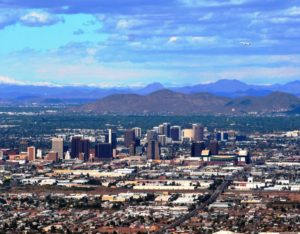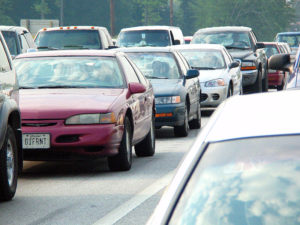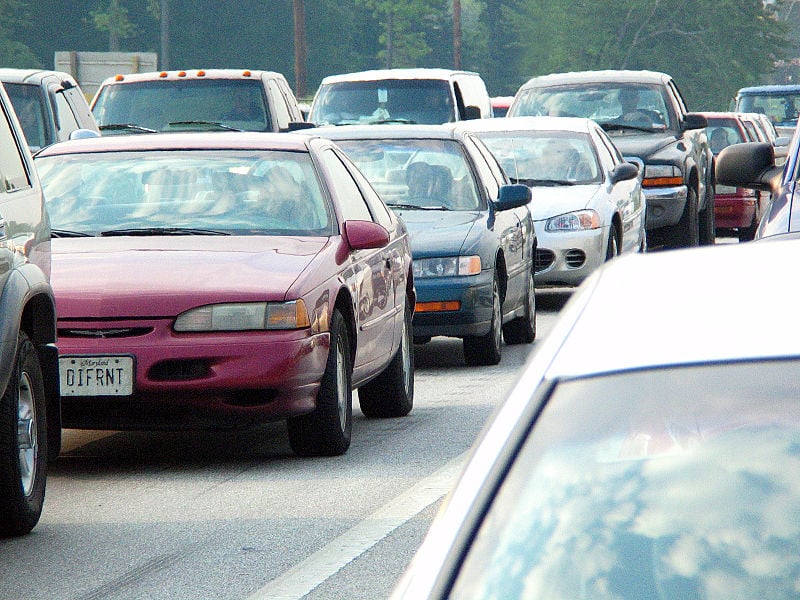I can’t count the times I’ve been stuck in freeway traffic. I remember driving from Long Beach, California to Phoenix, Arizona one Friday afternoon and returning on Sunday. The drive out: 9 hours. The drive back: 7 hours.
What we are effectively looking at is stop-and-go driving – at least until I got beyond the congestion end-point (more than likely this was east of San Bernardino).

Now you might have expected a like number of hours taken on the Sunday drive back.
That didn’t happen. All of that traffic leaving the Southland on that Friday afternoon and then, fortunately, this was not the case when on the return trip made on the Sunday evening following.
Which tells me, on the Friday that I left, I was just caught up in the end-of-the-workweek commute crush. And, had I returned to Long Beach during the morning rush-hour on the following Monday, it quite conceivably could have taken 9 hours in getting back.
It definitely stands to reason.
Thinking in the associative sense, had I departed the Orange County, California community either mid-morning or early afternoon that one Friday, by the time I got to Phoenix, it’d only have taken 7 hours instead of the 9 that it did.
Of course, if I wanted to avoid all of the roadway traffic, I could have flown, which would have allowed for a longer Phoenix stay, and, if there was any congestion to be experienced, it most likely would have occurred on Interstate 405 (I-405) between Long Beach and LAX. With parking and plane fare, that would have cost more than what it would have cost to drive. Not just that, but airplane travel is more polluting than car travel as information in the report High Speed Rail and Sustainability reveals, except where the pollutant sulfur dioxide is concerned. (See: “For National Transportation Week, road, rail, air compared”).

At any rate, outside of flying and high-speed train travel (which we do not yet have in the U.S.), on busy, busy freeways, how can one avoid the congestion mess?
Attempts at trying to find a solution or solutions have been ongoing.
The Los Angeles region provides an excellent case study. Build more capacity into the roadway network is one idea.
Okay, the way this is accomplished is by physically adding more roadway pavement.
For perspective, on I-405 between the San Fernando Valley and Los Angeles over the Sepulveda Pass for 10 miles (think Carmageddon and Carmageddon II), this was the very remedy implemented. Is that stretch any less congested today at rush-hour than what was the case before all of the roadway work and the money needed to pay for that was expended? In my mind – and the long and short of it – NO!
The amount of concrete added, by itself, could possibly have done the trick had traffic not increased during the times of peak demand. But, as far as I’m aware, that didn’t happen.
So, what’s that leave?
Okay, so let’s look at another option – the use of lanes having variable pricing attached. For purposes of this discussion, let’s just say that two new 10-mile-long lanes were added in each direction, post-upgrade.
The question is if variable-pricing opportunity applied to the two lanes nearest the median on both sides of the median were to go into effect, would that make a difference? In case you are unaware, a variable-pricing scheme is an arrangement whereby a toll or fee is applied to a lane or lanes of travel whereby motorists pay for the exclusive right to drive on that lane. Variable pricing is a way to limit the number of vehicles using a lane where a variable pricing strategy has been applied and is in effect.
And where it has, during times of high demand, the price for use of the lane is higher and when freeway traffic is lighter, said lane-use price is lower.

Of course, if people just drove less (the latest figures on U.S. driving indicate that such driving is up – 3.21 trillion aggregate miles driven in 2018 alone), that could help.
Such could take the form of public transit use (both rail- and road-based); carpooling, which also goes by the name ridesharing; driving during off-peak hours, which many apparently do; physically residing close or closer to where one works, shops, etc., staying home if there isn’t a need to go out; or in the case of shopping, have purchased items delivered to the home itself.
There is one exception I haven’t yet mentioned – the bypass. An example would be the new tunnel built between LAX and the city of Hawthorne, California, another Elon Musk first, where the use of a bogey of sorts to guide vehicle front wheels as it travels through said tunnel, such a system could be a very effective means of circumventing (bypassing) gridlock or congestion.
I, for one, think that if the aim is to get more traction where that’s concerned, then increase carrying capacity of vehicles using the tunnel bypass option – think subways. But, then again, that’s not a new idea.
Just in case you’re not up to speed, L.A.’s got those too!
Images: DGustafson (top); U.S. Census Bureau (middle)
– Alan Kandel

STAY HOME! (Dan Sullivan)
Dear Mr. Alan Kandel,
There could be a possible work around – especially with the advent of connected cars, V2V, V2I, cryptocurrency and high-frequency trading (quant). When all these are truly in place, we could have a potential scenario wherein, within constraints defined in the primary variables such as position & price, among the immediate bunch of freeway users, a length of travel can lead to gains in position on the road, or, concomitant gains in the means for the vehicles that trade places in the bargain, in the final analysis. After all, not everyone wants to show up early while still using the road. This trading could be effected over ad-hoc communications backbones among vehicles, with data security and embedded computing in place. The self-driven cars could be programmed to perform this trade-off within well-defined limits to realize a well-oiled and efficient transportation process. The day is not far when this becomes the de-facto.